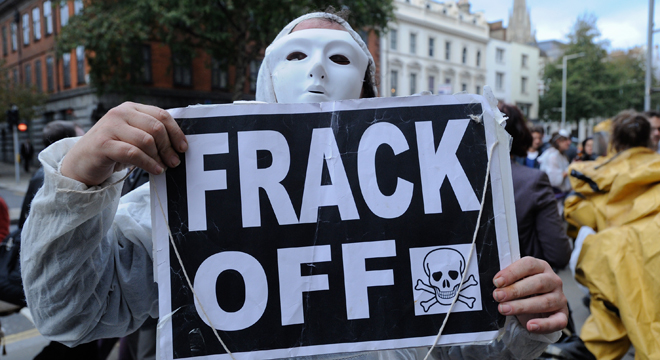One side points to videos of people setting their tap water on fire. The other looks to an economic boom in Pennsylvania. But New Yorkers in general are mostly split on whether to lift a moratorium on hydrofracking in the state, and the debate over the decision is likely to continue well into 2012.
Gov. Andrew Cuomo (D) had hoped that in the coming year the state would lift a moratorium on drilling in the Marcellus Shale in western New York. The shale, which also extends into parts of Pennsylvania, West Virginia and Ohio, is considered a prime source for extracting natural gas through a process called hydraulic fracturing, or fracking. This involves horizontally drilling into the shale rock and flooding it with chemicals to crack it open, allowing the gas to escape.
Over the past few years, there’s been a dramatic increase in hydrofracking activity in the shale. Pennsylvania, for instance, has issued over 8000 permits and started over 4000 wells since 2008. Drilling companies and other supporters of lifting the ban point to Pennsylvania’s recent economic windfall and a NYSDEC study that estimates fracking would directly create 25,000 jobs in New York.
Currently, New York has a ban on fracking permits in the shale, pending the release of new regulations by the New York State Department of Environmental Conservation. But though the NYSDEC had planned to release those regulations sometime in the new year, fears about the potential environmental impact of hydrofracking could delay a decision until the summer — or even until 2013.
A major concern is that the process could potentially contaminate the state’s water supply since the shale is so close to the main water source for much of the state — including New York City. In some fracking site-adjacent towns, homeowners have reported that their tap water has turned brown or become highly flammable.
Though drilling companies claim that the shale is too deep to effect drinking water — and that there has been no direct link between flammable tap water and the fracking chemicals — a recent report from the EPA linked fracking chemicals to contaminated water for the first time, after a study of groundwater in the town of Pavillion, Wyoming.
“We have long argued that new gas development using the risky fracking technology should not be permitted in New York unless and until it has been demonstrated that it can be done safely. We’re simply not there yet,” Kate Sinding, an attorney with the Natural Resources Defense Council, wrote in a blog post.
Emily DeSantis, an NYSDEC spokeswoman, said the report is “specific to Pavillion,” and that New York drilling would be even deeper “and not within underground sources of drinking water.”
“New York would require rigorous casing and cementing standards and a minimum of 1,000 feet of separation between the high-volume hydraulic fracturing activity and the deepest ground water,” DeSantis said, the New York Daily News reports.
It’s tough to pin down a direct link between the chemicals and water contamination, because as Elizabeth Kolbert explained in a recent edition of the New Yorker, the drilling companies can legally keep the chemicals in the fracking solution secret:
In the 2005 energy bill, largely crafted by Vice-President Dick Cheney, fracking was explicitly exempted from federal review under the Safe Drinking Water Act. As a result of this dispensation, which has been dubbed the Halliburton Loophole, drilling companies are under no obligation to make public which chemicals they use. Likely candidates include such recognized or suspected carcinogens as benzene and formaldehyde.
The NYSDEC began studying the environmental impact of hydrofracking in 2008, when the state first put its moratorium on fracking permits into place. Right now, the NYSDEC is in the public comment stage for its report on the potential environmental impact of fracking and proposed new regulations. It recently extended the length of this period from 90 days to 120 days, which means it will end on January 11.
In late November, the NYSDEC also held a series of hearings in New York over the plan to lift the ban — with high-profile guest appearances from actor Mark Ruffalo and “Gasland” documentary producer Josh Fox — so the NYSDEC could hear some of those public comments.
So far, the NYSDEC Commissioner says, they’ve received well over 15,000 comments, which means the review process could last until the spring, and a final decision on lifting the ban could even be delayed until 2013.
Another potential roadblock is proposed legislation by a bipartisan coalition of state lawmakers — including Sen. Greg Ball (R), and state Assemblymen Robert Sweeney (D) and Robert Castelli (R) — that would ban fracking for one year until more studies can be done on the potential environmental impact. Add that to the fact that Gov. Cuomo has not allocated any funds in the state’s budget for 2012 to regulate fracking and drilling, and there is a lot of potential for the decision to be put off for some time.
“Without the funding to properly regulate and without the manpower to properly oversee this industry, we must put the brakes on fracking,” Ball said in a speech last week. “It’s our fundamental responsibility to learn from the mistakes of other states like Pennsylvania and avoid the devastating effects of hydraulic fracturing here in New York.”
“Families have had their drinking water contaminated, experienced death of their livestock and witnessed the values of their homes drop by 90 percent. How is this acceptable?” Ball asked.
“Along with Senator Ball, I continue to support the idea for a moratorium on high-volume, horizontal hydrofracking until such a time all the evidence is in and we elected officials, who are stewards of the environment, can make an informed and intelligent decision on this important matter,” Castelli said, The Daily Peeskill reports. “This natural gas has been in the ground for 288 million years. It can stay in the ground a little longer until we make an informed decision.”









